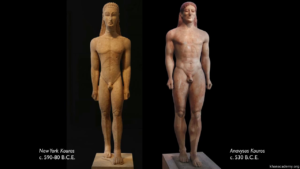Humanism is a philosophical ideal found in the Classical Era in Ancient Greece, later copied by the Roman empire. This philosophy referred to as humanism, was a major shift in society in which society was no longer “God-centered.” The function of society as we have spoken of in the Mesopotamian and Egyptian epochs was religious centered on pleasing and gaining the favor of the Gods; everything revolved around the Gods. Humanism is the shift of this societal function to revolve around men (literally).
In Greek and Roman art, this philosophy was easily distinguished in their marble and bronze sculptures of nude males. These sculptures are highly mimetic and naturalistic in an attempt to be faithful to the human anatomy. In fact, these sculptures, during the classical period gave little importance to emotion or cognitive expressions. Also other than being faithful to the anatomy they idealized beauty in these artworks. This is shown in the comparison we spoke of in class.
The first the Kouros of Attica, a sculpture from Egypt (as a precursor for Greek’s bronze works) is rigid and not as mimetic as the Greek’s adaption of the nude male. The anatomy is not as detailed although it is as rigid as the Anavysos Kouros. This Kouros, derived from the Egyptian Kouros, is much more evolved in terms of anatomy and idealized beauty. This ideal is then adapted into artwork such as the Doryphoros, in which muscle is toned and polished almost in a modern athletic manner and the man is much more idealized. His face is slightly thoughtful and his poise is contrapposto. The evolution of this philosophy through history is shown through these sculptures.



